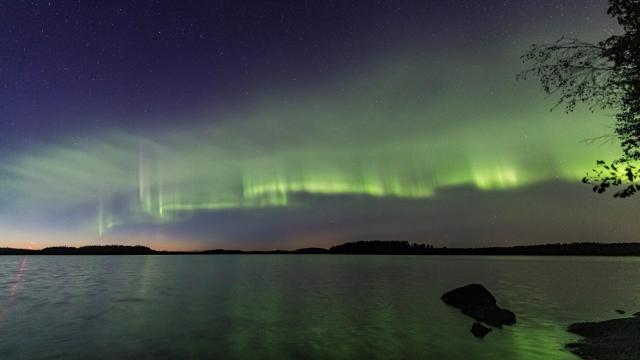A collaboration between physicists and citizen scientists has led to the discovery of a previously unknown form of Northern Lights. Dubbed “the dunes,” the spectacular auroral form is providing new insights into Earth’s upper atmosphere.
New research published today in AGU Advances describes the auroral dunes, which appear as undulating, green-tinged waves in the night sky. The dunes are appearing in the upper atmosphere and likely represent a previously unknown physical process. Physicist Minna Palmroth from the University of Helsinki and her colleagues are the first to document this type of aurora, but the discovery wouldn’t have been possible without the help of citizen scientists.
This story starts in 2018, when Palmroth was preparing a popular guidebook called Revontulibongarin opas, which is Finnish for “a guide for aurora borealis watchers.” Auroral forms come in various types, and each is associated with a specific set of physical processes that happen along the edge of space. Palmroth’s book project, which arose from her work with Northern Lights enthusiasts on Facebook, described several auroral forms, but her readers noticed that a certain type of aurora seen in the book hadn’t been categorised. They dubbed it “dunes.”
“I looked at the pictures and thought, maybe we need to make a new category, because they didn’t seem like anything I had seen before,” Palmroth told Gizmodo. “Then we started to investigate this together, using the citizen pictures as science data, and since we hadn’t done that sort of thing before, we had to develop new methods.”
Indeed, new auroral forms aren’t discovered every day. An atmospheric effect known as STEVE made headlines recently, but this strange light show is technically not an aurora and is instead an optical phenomenon still in need of an explanation.
Auroras, on the other hand, occur when solar particles interact with gases in Earth’s ionosphere (the part of our planet’s atmosphere that’s ionised by solar and cosmic radiation). Nitrogen reacts by glowing blue and purple, while oxygen gives off green and red light. In the case of the newly documented dunes, these monochromatic auroras are believed to be glowing waves of oxygen atoms, which are being struck by streams of electrons, according to the new research.
Fortuitously, the dunes appeared in the night sky on October 7, 2018—just days before Palmroth was set to publish her book. Amateur observers captured multiple photos of the same dunes at the same time from different locations in Finland. Pictures taken by the citizen scientists and others collected elsewhere at different times subsequently formed the “backbone” of the new study, as the authors wrote in the paper.
By using background stars as reference points, Palmroth and her colleagues were able to triangulate the position of the dunes from two locations in Finland that are separated by 172 kilometres. Results showed that the dunes were appearing at an altitude of 100 kilometres. For the event on October 7, 2018, the distance between each auroral ripple, or wavelength, was measured at around 45 kilometres, based on the appearance of six consecutive dunes.
Interestingly, the dunes were spotted within the mesosphere and slightly below the region immediately above it, known as the mesopause. This part of the atmosphere, where our planet’s atmosphere intersects with space, is notoriously difficult to study, leading scientists to refer to it as the “ignorosphere.”
“The ignorosphere is too high for radars and balloons, but too low for satellites, therefore there are very few measurements of it altogether—mostly from rockets,” Palmroth told Gizmodo.
The dunes are likely forming due to a surge in oxygen density in this part of the sky. The researchers attributed this to an effect called a “mesospheric bore,” which can be compared to a tidal bore, when a tide travels up a river. More technically, mesospheric bores are “a type of gravity wave disturbance that propagates through air, sometimes creating rippling patterns in high-altitude clouds that can be seen with the naked eye,” according to the American Geophysical Union.
As Palmroth explained to Gizmodo, more auroral lights happen in places where the oxygen is dense, and fewer auroral lights happen where the oxygen is scarce. The bore waves are causing oxygen density to increase and decrease, “and that’s why we see the dunes,” she said.
This is significant because the researchers are able to “see” the bore by virtue of the aurora, which has never been done before. “By investigating the dunes, we can get information about the bore waves,” said Palmroth. What’s more, the presence of these mesospheric bores in the ignorosphere may give scientists a new way of investigating this region, she added.
Looking ahead, Palmroth would like to gather more observations of the dunes to allow for further investigations. Once again, the efforts of amateur skywatchers would be welcomed.
“It was such a great thing to work with the citizen scientists,” said Palmroth. “We really enjoyed it.”
